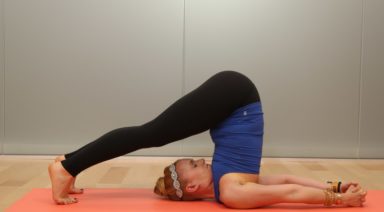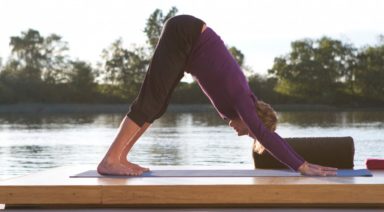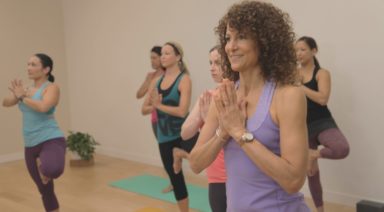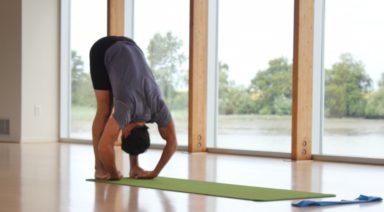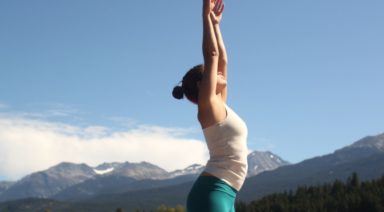Pranayama Benefits and Techniques

Practitioners of traditional Indian medicine (Ayurveda) tell us that the human body is made up of five separate elements (earth, water, fire, wind and space), three separate humors (called dosas) and our consciousness.
The earth element, according to the yoga scholar Françoise Wang-Toutain et al., forms the solid components of our body, and space forms the internal cavities through which all of the other elements flow. Fire and water are propelled by wind. Wind, in this instance, refers not only to our gross breath, but also to the basal energetic forces that govern all of our bodily functions.
The traditional name for these energetic winds is “vayu”. Said to be ten in total, these vayus are sub-units of a “master” wind (pranavayu) that joins our mind together with elements from our mother and father at the moment of our conception.
As we continue to develop in the womb, the pranavayu sub-divides itself into five primary and five subsidiary winds. These winds then provide the energy for essential bodily functions such as circulation, elimination, assimilation, respiration and locomotion.
When the vayus function efficiently, the body enjoys good physical health and mental clarity. When the winds become imbalanced or the channels through which they flow become damaged and sickness, disease and ill health arise.
Wang-Toutain et al. states that control of the breathing process (pranayama) provides one of the most direct methods to expand the life force and balance the vayus. Because of this, traditional Hatha Yoga practices rely heavily on pranayama practices for greater health and vitality.
Benefits of Pranayama
The Hatha Yoga Pradipika, a seminal text on pranayama practices, mentions a number of benefits that can arise as the energy winds are drawn into balance. These benefits include a “glowing countenance”, weight reduction, improved digestive capabilities, and a reduction in symptoms from a number of diseases.
Modern researchers have found that the benefits of yoga and pranayama practices include improvements in mood, increased energy, stress and anxiety reduction, better neurological functioning, and improved physical health.
A caveat: It’s important to note that the pranayama practices included in the Hatha Yoga Pradipika are typically done as part of a holistic regimen that also includes a number of additional purification techniques, dietary shifts and herbal remedies. If you wish to include pranayama practices as part of a healing regimen, it’s always best to practice these exercises under the guidance of a trained Ayurvedic specialist.
Pranayama Techniques for Home Practice
If you wish to practice pranayama techniques for yourself, it’s always important to begin slowly. Many traditional pranayama exercises utilize breath retention exercises in order circulate energy through the body. When overdone, these exercises can strain the lungs and create further imbalances in the energy system, so it’s always important to do them slowly, gently and according to your capacity.
*Please note that breath retention practices are contraindicated for expectant mothers.
How Should I Sit When Practicing?
Swami Svatmarama recommends the full lotus pose for pranayama practitioners. While the lotus provides one of the best supportive bases for those who can do it, the posture is notoriously challenging if your hip muscles are tight or you are simply not used to sitting on the floor for extended periods of time.
Because of this, you should feel free to sit in any seated posture that will allow you to keep your spine straight. If you are most comfortable sitting in a chair, feel free to use one.
Pranayama Exercises
The first exercise in the Hatha Yoga Pradipika is an alternate nostril breath with a breath retention at the end of every inhale. If you’ve never done pranayama before, this can be pretty challenging.
Because of this, I’ve included two simple exercises that can be used to prepare for the breath retention practice included in the Pradipika. If you’ve never done pranayama before, practice the following two exercises daily for at least two weeks each before going on to the third.
Sama Vrtti Pranayam (the Breath of Equal Duration)
Regular practice of this pranayama technique will help you to develop the ability to control the duration of your breath without force or strain. Benefits of this pranayama include stress reduction, increased energy, a deeper lung capacity and heightened ability to concentrate.
- Find your way to a comfortable seated position.
- Direct all of your awareness to your inhale and exhale.
- Make your inhale and exhale equal by inhaling to a count of five, four, three, two one, and exhale to the same count.
- With practice, increase the duration of each inhale and exhale until you can breath in and out to a slow count of ten.
- Practice a minimum of seven repetitions or as many as you are comfortable with.
Nadi Shodanam Version 1 (Energy Channel Cleansing Breath)
- Take attention to your right hand. Place the tip of the index and middle finger on the space between your eyebrows.
- Use your thumb to block your right nostril, and inhale fully through the left.
- Block your left nostril with your thumb, and exhale fully out the right.
- Reverse the process. Breathe in through the right side, and out through the left.
This cycle completes one full round.
Note: As you breath in and out, attempt to make your inhales and your exhales approximately equal in length, just as you did in Sama Vrtti Pranayama. Mentally count the length of the breath, and expand the count as the breath becomes easier.
Begin with seven full rounds of this breathing pattern. As it becomes easier, work up to more in accordance to your capacity.
Nadi Shodanam Version 2 (the Alternate Nostril Breath)
After a few weeks of practice, you may find that you’re ready to begin Nadi Shodanam. This powerful practice is the first breathing exercise mentioned in the Hatha Yoga Pradipika.
The breathing pattern in this form of Nadi Shodonam is identical to what you’ve already learned with one notable exception: in this practice, the breath is retained at the top of every inhale.
Holding your breath draws prana (life force) into your body and allows the energy to circulate more fully through your system. With time, this process can help to balance your energy winds and repair damage to the energy channels through which your prana flows.
Swami Svatmarama writes that this pranayama has the potential to fully purify the body’s energy channels when practiced four times per day for three months.
To practice:
- Bring your attention to your right hand. Place the tip of your index and middle finger on the space between your eyebrows.
- Use your thumb to block your right nostril, and inhale fully through the left.
- Hold your breath at the top of your inhale for as long as is comfortable
- Block your left nostril with your thumb, and exhale fully out the right.
- Reverse the process. Breathe in through the right side, hold your breath at the top and breathe out through the left.
Once you’ve grown accustomed to the breath, practice making your inhale, retention, and exhale equal in length.
Kapalabhatti Pranayam
Kapalabhatti Pranayam (the skull-shining breath) is one of six additional cleansing practices mentioned in the Hatha Yoga Pradipika. Benefits of this exercises include increased energy and heightened mental clarity.
In this practice, exhales are short and active and inhales are passive. Inhales occur as a result of forcing the breath out in short, quick bursts through the nostrils (sort of like the breath that you use to blow out a birthday candle, only through the nose instead).
To begin:
- Find a comfortable seated position.
- To begin the first round of kapalabhatti, inhale deeply through your nose, and then exhale half of your air.
- Once your lungs have emptied approximately halfway, squeeze the muscles of your belly down and in to press air out through your nose in a quick burst. Relax your belly and let the lungs effortlessly fill to halfway again.
- Repeat according to capacity, building up to three rounds of fifty repetitions.
Note: Becoming comfortable with Kapalabhatti pranayama can take some practice, so go slowly at first. The slower tempo will allow you better feel the active nature of the exhale and the passive nature of the inhale. Pay attention to any feelings of dizziness or breathlessness and stop the exercise for the day if they arise.
One Fluid Practice
At first, it’s best to practice each of these exercises one at a time. For example, you might consider practicing Sama Vrtti Pranayama for a few weeks before beginning Nadi Shodanam version 1. Once you’ve got it down, practice both exercises in one session.
When you’re ready to progress, add the next practice in the cycle until you are able to do all of the breathing exercises together as one full sequence. As you practice, rest as much as necessary and avoid force or strain.
Pranayama for Health and Vitality

What Is Prana?
Prana is the sum total of all energy that is manifested in the universe. It is the vital force, Sukshma. Breath is the external manifestation of Prana. By exercising control over this gross breath, you can control the subtle Prana inside. Control of Prana means control of mind. Mind cannot operate without the help of Prana. It is the Sukshma Prana that is intimately connected with the mind. Prana is the sum total of all latent forces which are hidden in men and which lie everywhere around us. Heat, light, electricity, magnetism are all the manifestations of Prana. Prana is related to mind; through mind to the will; through will to the individual soul, and through this to the Supreme Being.
The seat of Prana is the heart. Prana is one; but it has many functions to do. Hence it assumes five names according to the different functions it performs, viz., Prana, Apana, Samana, Udana and Vyana. According to the different functions they perform, they occupy certain places in the body.
Breath directed by thought under the control of the will is a vitalising, regenerated force which can be utilised consciously for self-development, for healing many incurable diseases and for many other useful purposes. Hatha Yogins consider that Prana Tattva is superior to Manas Tattva (mind), as Prana is present even when mind is absent during deep sleep. Hence Prana plays a more vital part than mind.
If you know how to control the little waves of Prana working through mind, then the secret of subjugating the universal Prana will be known to you. The Yogin who becomes an expert in the knowledge of this secret, will have no fear from any power, because he has mastery over all manifestations of power in the Universe. What is commonly known as Power of Personality is nothing more than the natural capacity of a person to wield his Prana. Some people are more powerful in life, more influential and fascinating than others. It is all through this Prana, which the Yogin uses consciously by the command of his will.
Pranayama
Prana
Vital force, vitality, nourishment, upward flowing
Yama
Control
- Ujjayi (Victorious breath)
Sit comfortably, easily. Close the mouth. Inhale slowly through both the nostrils in a smooth, uniform manner.
Expand the chest when you inhale. During inhalation a peculiar sound is produced owing to the partial closing of glottis. The sound produced during inhalation should be of a mild and uniform pitch. It should be continuous also. This breath technique may be practised even when walking or standing – exhale slowly through both nostrils making the same sound.
Benefits: This removes the heat in the head. The practitioner becomes very beautiful. The gastric fire is increased. It removes phlegm in the throat. Asthma, snoring, beneficial for thyroid problems, consumption and all sorts of pulmonary diseases are cured. All diseases that arise from deficient inhalation of oxygen and diseases of the heart are cured. All works are accomplished by Ujjayi Pranayama. The practitioner is never attacked by diseases of phlegm, nerves, enlargement of spleen, dyspepsia, dysentery, consumption, cough or fever. Improves mental health and particularly the nervous system. Perform Ujjayi to destroy decay and death.
- Kapalabhati (the breath of fire or the skull shining breath, invigorating, energizing, and purifying)
Very active forced exhalations with a passive inhalation – while exhaling – quickly pump the belly into the back of the spine forcing the air out of the nose. Place one of your hands on your belly if you so wish in order to feel more the action. KEEP STEADY RHYTHM. Do 3 sets of 30 repetitions.
Avoid if under high medication for blood pressure, recent abdominal surgery/injury or pregnancy.
Benefits: Maintains good health and fights disease, nadis (nerves) of the brain get good exercise, regular practice (10-15 min daily) will aid in riding forehead of wrinkles, improves luster of skin, strengthens nerves and brain centers, massages internal organs.
- Bhastrika (Bellow’s breath)
Rapid sucession of forcible breaths. Sitting in Vajrasana (hero’s pose or kneeling), hands resting on your lap, palms facing upward. Take a few calming natural breaths to prepare. Bring your hands in a fist position by the side of your shoulders. – Inhale powerfully through the nose and raise your arms above your head with open hands, exhale forcefully as you bring your arms back to starting position, continue for the required amount of repetitions. On the last exhalation – follow it by a deep possible inhalation – breath is suspended for as long as it can be done with comfort, simultaneously: engage the lower bandhas (pelvic floor closes and belly button pulls back to back of the spine, both to 30% of max) follow it by a slow and deep possible, exhalation. – Rest for 5 deep normal breaths before starting again. – 3 sets.
Benefits: Relieves inflammation of the throat, increases gastric fire, removes disease of the nose, chest and eradicates asthama, it gives good appetite, breaks and dissolves tumors, wakes up kindalini energy, removes all diseases which arise from excess wind, bile and phlegm, gives warmth to the body, purifies the nadis considerably, useful in muscular dystrophy and oxygen deficiency disorders, it balances the 3 doshas, purifies the blood, helps to rid body of foreign intruders and toxins, stabilizes prana, calms the mind and nervous system.
- Shitali (The cooling breath)
Roll the tongue into a tube (as best as you can) and stick the tip of the tongue out of the mouth. Inhale through the tongue and hold the breath in for 4-5 seconds with the chin pressed against the chest. Exhale using Ujjayi Pranayama through the nose. Repeat 5-10 times.
Benefits: Lowers temperature of the body in the heat, quenches thirst,cures acidity, hypertension, skin diseases, removes impurities from the blood, improves overall fitness, brings a glow to the face.
Sound is the highest vibration of consciousness
Sound is carried through the bones of the human body.
Your consciousness is laying dormant at the bottom of your pelvic cavity (pelvic floor area) and in order to wake it up, one must use sound (vibration), movement and breath.
CHANT “OM” (oum) 3 TIMES AT THE BEGINNING OF YOUR PRANAYAMA EXERCISES.
OM: Universal/Primordial sound of everything, – It is the root of all mantras.
Mantras: Combination of Sanskrit words that have a soothing effect in the sympathetic system (stress response/ flight 2 flight response mechanism)






















